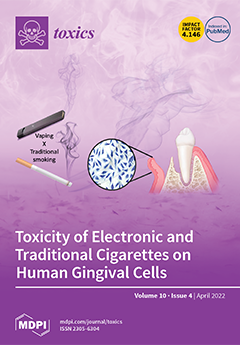This study provides baseline information on the concentrations of antibiotics in influent and effluent from two wastewater treatment plants in regular operation in the State of Kuwait. Wastewater samples were collected from the influent and effluent streams of two WWTPs, over four sampling
[...] Read more.
This study provides baseline information on the concentrations of antibiotics in influent and effluent from two wastewater treatment plants in regular operation in the State of Kuwait. Wastewater samples were collected from the influent and effluent streams of two WWTPs, over four sampling campaigns and analyzed for a broad range of antibiotics. The mean influent concentrations of sulfamethoxazole, ciprofloxacin, clarithromycin, and cefalexin were 852 ng/L, 672 ng/L, 592 ng/L), and 491 ng/L, respectively, at Umm Al Hayman WWTP. At the Kabd WWTP, the influent concentration of clarithromycin was highest with a mean of 949 ng/L, followed by ciprofloxacin (mean, 865 ng/L), cefalexin (mean, 598 ng/L), and sulfamethoxazole (mean, 520 ng/L). The dominant compounds in the effluent from Umm Al Hayman were sulfamethoxazole (mean, 212 ng/L), ciprofloxacin (mean, 153 ng/L), ofloxacin (mean, 120 ng/L), dimetridazole (mean, 96 ng/L), and metronidazole (mean, 93 ng/L). Whereas, at the Kabd WWTP, the dominant compounds were sulfamethoxazole (mean, 338 ng/L), dimetridazole (mean, 274 ng/L), cefalexin (mean, 213 ng/L), ciprofloxacin (mean, 192 ng/L), and clarithromycin (189 ng/L). The mean influent concentrations of all compounds were higher than those measured in the effluents. The concentrations of antibiotic compounds were not significantly different between the two WWTPs (
p > 0.05). The removal efficiencies of the various antibiotics over the four sampling campaigns for the Kabd and Umm Hayman WWTPs ranged between 10.87 and 99.75% and also showed that they were variable and were compound dependent. The data clearly show that the concentrations of antibiotics measured in the influents of both WWTPs were highest in samples collected during the winter-summer (September samples) transition followed by the concentrations measured during the winter-summer (March samples) transition period. This is possibly linked to the increased prescription of these medications to treat infectious diseases and flu prevalent in Kuwait during these periods. This study provides the first reported concentrations of antibiotics in the dissolved aqueous influents and effluents of WWTPs in Kuwait. Additional studies are required to evaluate the environmental impact that antibiotic residues may cause since treated wastewater is used in irrigation, and often there are instances when untreated wastewater is discharged directly into the marine environment.
Full article






